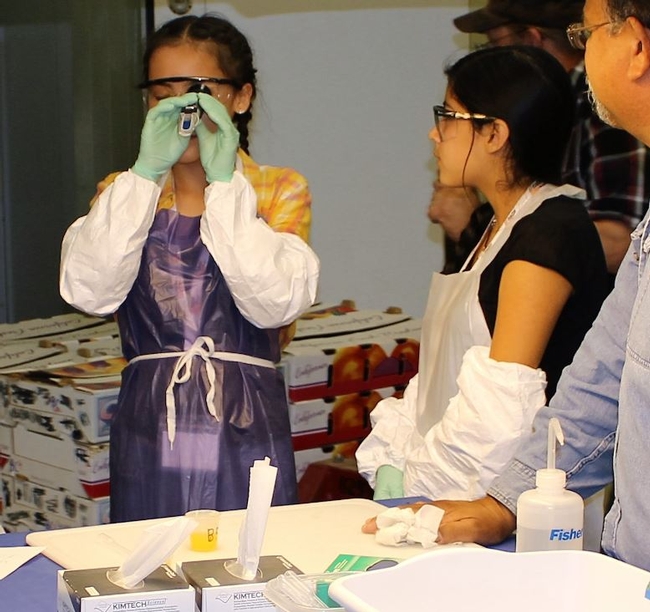Reedley College provides upward bound math and science programs to 405 students from ten high schools ranging from Madera to Dinuba. These programs serve mainly low-income and first generation college bound students with a goal of generating enthusiasm for science and math leading to increased college enrollment. About a quarter of these students attended workshops at Kearney in June and July.
Kris Tollerup, UC Cooperative Extension advisor in the statewide IPM program and at Kearney Agricultural Research & Extension Center (KARE), almond, pistachio, tree fruit and grapes, taught a workshop on integrated pest management (IPM) strategies and practices. Students went to the fields and performed insect collection sweeps in alfalfa. They used dissecting microscopes to assist with identification of beneficial, neutral, and pest insects. Students learned about IPM strategies as well as how the practices and crops in one grower's field can impact his or her pest pressure as well as the pest pressure in a neighboring grower's crop.
Andreas Westphal, UC Cooperative Extension assistant specialist in the Department of nematology at UC Riverside and KARE, pathogens and nematodes affecting plants, taught the students about nematodes. Students used compound and dissecting microscopes to help identify different nematodes and different stages of nematode development. Samples of plant damage were also available. This workshop included IPM strategies for plant parasitic nematode pest management.
Jeff Mitchell, UC Cooperative Extension specialist at KARE, statewide cropping systems, taught the students about population predictions and the need to find ways to increase food production, increase available quality water, and sustain the environment. Students learned about conservation tillage, soil texture, soil stability, and leadership. They conducted soil texture and soil stability tests. Students discussed how much better the conservation tillage soil's stability and water infiltration was compared to the conventional tillage soil.
Themis Michailides, plant pathologist in the Department of plant pathology at UC Davis and KARE, ecology, epidemiology and control of fungal diseases of fruit and nut crops and vines, postharvest diseases, aflatoxin and mycotoxins of nut crops and figs, taught students about different pathogens, beneficial organisms, and the impact of certain organisms. Students used compound and dissecting microscopes. Larger samples were also available to see the symptoms and visible damage to the host plant. IPM strategies were discussed.
KARE staff provided 3 workshops.
-Students learned about sensory evaluation. Students took turns preparing and delivering samples and being the consumer that determined consumer acceptance. Different strategies to make the data more robust were discussed and demonstrated. Students discussed the results and observed the variation in consumer preferences. They used raw agricultural as well as value added commodities. There was insufficient time for statistical analysis, but the general concepts and impact of statistical analysis were discussed.
-Students discussed different experimental designs and terms. They visited actual research fields and learned how the plots are laid out and how the variables are controlled to help address certain issues and obtain robust data that is useful to stakeholders.
-Students also learned how and why fruit maturity and quality standards were set, as well as methodologies for determining fruit maturity and quality. They performed fruit maturity and quality testing in a laboratory setting and compared their objective and subjective assessments of the fruit. To get the sugar to acid ratio, students conducted titrations and used refractometers. Students used a penetrometer to determine fruit firmness. Some of the students toured other labs in the facility and learned about pathology efficacy trials and altered atmosphere strategies.
Author - KARE Program and Facility Coordinator, IR-4 Field Research Center Director
